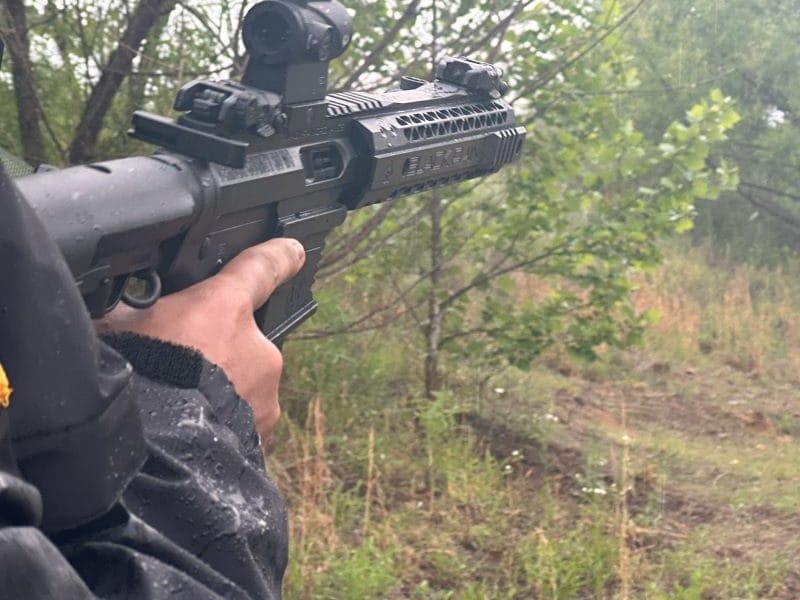Range day equals fun day, well most of the time. That’s the day you get to try a new drill, shoot a new gun, or improve your skills with your favorite gun. I like the drills that cause you to move around, transition from one gun to another, change magazines, etc. But how often do we think about real-world scenarios when heading to the range? Do we switch things up to simulate some of the obstacles that could get in our way? My agency set a date for department qualifications and shortly after setting it, the forecast changed for rain, rain, and more rain.

I live in a part of the country that likes to surprise you with the weather and every day is different. A warm sunny day means nothing when predicting what tomorrow will be like. At first, the decision was made to reschedule qualifications and wait for better weather. But then someone brought up the question, why? We work in the rain, and any type of incident could happen in the rain. So why not train just as where a call everyone was responding to? The decision was then made to continue with qualifications, even in a downpour.
I don’t know if I would call this day fun, but we did gain some insight into a few things that most of us probably never think about. Sometimes it’s the simple things that turn out to be our biggest obstacle. Here are some of the things we found to become an issue when shooting in the rain.
Decreased Visibility
We all know visibility is reduced in the rain. On the range, overall visibility can be more of a hindrance than first imagined. When mixing shoot or don’t shoot targets into the scenario, heavy rainfall makes it harder to focus on smaller details, like a person’s hands. Another issue with visibility is the combination of rain and glass.
If you wear glasses, rain is even more of a challenge. A raincoat or something with a hood can help keep the rain off glasses and out of your eyes. but most people will never have time to put a raincoat on in an emergency if they weren’t already wearing one. Like anything else, you need to adapt and adjust as you go. It may be necessary to move closer to the target during heavy rain if you can’t see as well. But it’s easy to get in the habit of thinking we can perform the same, regardless of weather.

We experienced more issues with handguns than rifles. In some cases, the water on the lens made it hard to see through. A few people had problems with the rain interfering with the dot reflection on their handguns, causing them to see multiple red dots on the lens. This is a time when co-witness sights are important to have on your firearm.
Loading and Clearing Malfunctions
Handling a gun in the rain is another one of those little things that no one really thinks about. I mean, it’s not really that big of a deal, right? Most people never have their gun in the rain. A gun is an expensive investment, and we take care of our stuff. Water and moisture are natural enemies to firearms, so we keep them dry, oiled, and stored in dry places. But it’s surprising how hard it becomes to handle all your gear when everything is soaking wet.

Dealing With the Elements
If you’re in a large city where everything is paved, you more than likely won’t have to deal with mud. But pavement can still be slippery, and this causes the same effect as mud. Everyone knows to be more careful with their footing when the ground is wet, but when we are experiencing a life-or-death incident, we don’t think about everyday things. We focus on staying alive and our body does whatever it has been trained to do.

This becomes a habit for your body, which is a good thing, except when it’s wet. If the ground is muddy or the pavement is wet, you must take smaller steps and not throw as much leverage onto one foot. If you would normally be wearing a coat, or some type of jacket, keep it on during the training. Training with a coat over your gear or a rifle sling over your coat may change how you do things.
Ready to mix up your training?
Training for real-world scenarios isn’t hard, but we do have to change a few things. It’s easy to “dress” for the range, but this isn’t always how we dress every day. There is nothing wrong with a fun day of shooting some targets or running drills, but honestly how many of us really train when the weather is bad?
Rain, snow, wind, extreme heat, and cold are all conditions that will change how we function with our gear. If we are used to shooting in nice weather, what happens when we need to defend ourselves out in public wearing a heavy coat and gloves? I have had countless firearms classes on cold windy days that presented issues for the students. Many forget to bring gloves because they don’t wear gloves normally.
Their fingers would go numb, and they couldn’t handle their firearm properly. Have you tried shooting with the gloves you wear in the winter? No one really enjoys shooting in inclement weather, well not normal people anyway, but it’s good to do every now and then.
It’s like every other type of training we do. Put your body through the motions under different scenarios so it becomes familiar with functioning in that environment. Remember to clean your guns and gear thoroughly so that nasty rust doesn’t creep up on you. Just remember, training is not meant to be comfortable, it’s meant to condition your body to stay alive.


